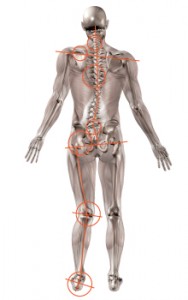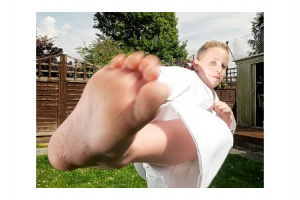OK, this is the last post on this subject, I promise 🙂
There is a certain attitude in martial arts, that we don’t like to give in to pain or to complain about it. We just soldier on. But if you are suffering any kind of joint of pain or discomfort, get it properly checked. I would recommend a good Osteopath, Chiropractor, Podiatrist or something similar rather than an ordinary doctor (known as a General Practitioner [GP] in the UK). My personal experience is that when it comes to any kind of sports or physical activities injury, the GP will just tell you not to do it any more. Well it makes his job easier!
 That of course is not a satisfactory answer to a martial artist who wants his/her martial art to be a lifetime study. Also (in my personal experience) the GP tends to look only at the symptoms and not what might actually be causing the problem.
That of course is not a satisfactory answer to a martial artist who wants his/her martial art to be a lifetime study. Also (in my personal experience) the GP tends to look only at the symptoms and not what might actually be causing the problem.
Osteopaths and Chiropractors on the other hand tend to look at the body more holistically and are much more geared to getting us back into our chosen activity (be it sport or martial art).
When I was about 20, I had a problem with my knee. There was so much swelling that fluid dropped down to the ankle which literally became about twice the size (due to the excess fluid). After visiting the GP and having my knee examined I was told that he could not find anything wrong with the knee and to rest it.
So I rested, selling went down, trained, swelling came back, rested longer, swelling down, trained, swelling came back.
Back to the GP. Another examination of the knee revealed nothing wrong and I was told to rest it longer. So . . . . . . . rest it longer, swelling down, trained, swelling back, rest it longer, swelling down, trained, swelling back.
GP!
I was sent to the local hospital for an X-ray of my knee. Guess what they found?
Nothing.
Guess what the advice was?
Yes you guessed it, rest it even longer.
That had taken about 3 months. Desperate to get back to my training I tried an Osteopath. He actually looked beyond just my knee. He found a small mis-alignment in my hip joint which was affecting me knee. He did a manipulation on the hip that night, told me to go back to training and take it easy at first and gradually build back up. The problem disappeared and I very soon was able to get back into full training. In 3 months of going to the GP and the hospital, they hadn’t even looked at the hip.
Now when it comes to Osteopaths and Chiropractors you have to shop around as they are not all good. If you can, get a personal recommendation.
Another common problem these days is fallen arches in the feet. This is common because our feet were not designed to walk of flat surfaces, they were designed to walk on sand, mud, earth etc, which our ancestors would have done bare feet. On these surfaces, the arch of the foot is supported by the sand/mud/earth etc. However, on flat surfaces which we have in every home, every office or factory, every pavement/sidewalk, or every training room floor; our arches are not supported (unless you wear special shoes).
Why is this an issue?
When your aches fall, your foot tends to rotate slightly to the inside edge. This realigns your legs. Over a period of time your muscles, tendons, ligaments etc will adjust and assume slightly new positions. When you exercise vigorously, these new positions can cause all kinds of problems as mis-aligned parts rub against each other causing inflammation, swelling and pain.
Over yet more time, this can even affect your back giving you back pains.
I know this from personal experience. Having been off training for a number of years due to a lot of domestic problems, my arches fell causing constant pain and discomfort with my knees when I did start training again. It was a Chiropractor who pointed this out to me and arranged for me to have an orthotic insert to wear inside my shoes. This supports the arch and adjusts the mechanics of how I walked. Over time there has been a marked improvement. I later went to see a Podiatrist to get a made to measure orthotic inserts rather than the off-the-shelf orthotics from the Chiropractor. Gradually, slowly the situation has improved. It’s still not perfect, but I’m able to kick much better and relax and sink into my stance more easily (most of the time).
I can’t emphasise enough, if you are in pain when you train, get yourself checked out. Try non-evasive treatments first (operations can’t be undone). If they don’t work, then you can move on to the more drastic options later such as possibility of an operation.
Some supplements are good for joints too (though they won’t help much if the joints are mis-aligned). Many people swear by Cod Liver Oil or Glucosamine. Others use Ginger. The thing that worked best for me is Collagen. Until fairly recently collagen molecules could not be absorbed by the body orally as the molecules were too big. Now some variants can be. However, I would suggest you experiment to see what works best for you.




